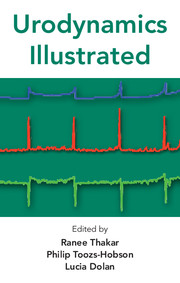Book contents
- Frontmatter
- Contents
- About the authors
- Acknowledgements
- Glossary and abbreviations
- Preface
- 1 Introduction
- 2 Setting up the equipment
- 3 Flow rate testing
- 4 Cystometry
- 5 Videocystourethrography
- 6 Ambulatory urodynamic monitoring
- 7 Urodynamic artefacts
- 8 Assessment of urethral function
- 9 Bladder diaries
- 10 Pad testing
- 11 Pre-test assessment using questionnaires
- 12 Ultrasound as a tool in urodynamics
- Index
1 - Introduction
Published online by Cambridge University Press: 05 February 2014
- Frontmatter
- Contents
- About the authors
- Acknowledgements
- Glossary and abbreviations
- Preface
- 1 Introduction
- 2 Setting up the equipment
- 3 Flow rate testing
- 4 Cystometry
- 5 Videocystourethrography
- 6 Ambulatory urodynamic monitoring
- 7 Urodynamic artefacts
- 8 Assessment of urethral function
- 9 Bladder diaries
- 10 Pad testing
- 11 Pre-test assessment using questionnaires
- 12 Ultrasound as a tool in urodynamics
- Index
Summary
The term ‘urodynamics’ encompasses a range of investigations which investigate the physiology and pathophysiology of the lower urinary tract. It may include one or all of the following:
□ uroflowmetry
□ standard cystourethrography
□ videocystometry
□ ambulatory monitoring
□ urethral function tests
□ pad tests.
Why perform urodynamics?
Urodynamic investigations are the cornerstone of understanding lower urinary tract symptoms. Historically, these investigations have been responsible for a seismic shift in our understanding of bladder physiology and pathophysiology, yet they remain controversial, simply because of the common failure to understand the basic principle of biological variation in the intermittent presentation of symptoms associated with pathology.
Urodynamic investigations are used to investigate bladder function and dysfunction in women with urinary symptoms, the most common being urinary incontinence. Guidance from the National Institute for Health and Clinical Excellence covers much of when investigations should be performed. Broadly speaking, urodynamics is used when conservative therapies fail or when the woman has complex symptoms or failed previous surgery. There are a number of tests available, each offering a different insight into lower urinary tract symptoms. However, exact protocols will be based on local service provision.
The first key principle is whether the test explained the symptoms. If it did not, is another test indicated? The second key principle is never to force the diagnosis. Referral should be based on local services as appropriate.
Keywords
- Type
- Chapter
- Information
- Urodynamics Illustrated , pp. 1 - 4Publisher: Cambridge University PressPrint publication year: 2011

